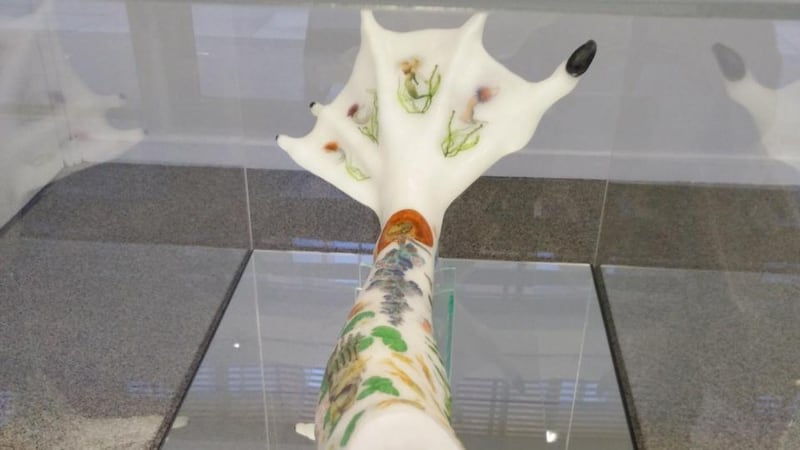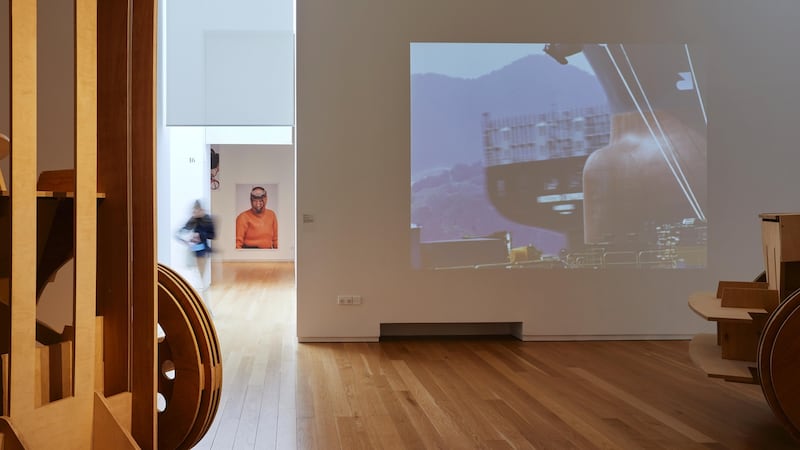Future Proof
★★★★
The LAB, Until Dec 14th
A show about science in a gallery called The Lab seems like a match made in heaven. In fact, art and science have been more like star-crossed lovers over the centuries. Happily together in da Vinci’s day, The Enlightenment paradoxically alienated one from the other.
Despite official positions, and just like artists, the best scientists have always eschewed dogma, preferring open-minded experimentation, leaps into the unknown, and quests for ways to greater understanding of the mysteries of the world around us. It’s such a shame that our education system privileges one over the other, that STEM isn’t STEAM.
Smart people know the value of curiosity, and programmes such as UCD’s Parity artist residencies, housed in converted labs in the School of Physics, open the doors of dialogue.
So too does this exhibition, which includes Parity co-founder and director Emer O'Boyle, current residents and alumni (Maria McKinney, Brian Duggan, Méadhbh O'Connor), as well as Sofie Loscher, Lucy McKenna, Siobhan McGibbon, Matt Parker and David Stalling.
Collectively they imagine both the consequences and the what ifs of our world, exploring ways of looking, and showing some of the flaws in the ways in which we currently see the “truth” of the world.
Given that art and science both begin in the imagination, it seems strange that children are so definitively encouraged to think in terms of one or the other. McGibbon's brilliantly weird Xenothon: Museum of the yet to come, Artefact: Xenothorpian leg (2017) is a wax model of a tattooed limb, complete with webbed foot and claws. Drawing on the Xenothon Project, a collaboration with Maeve O'Lynn, and the artist's CúRAM residency at NUI Galway, it imagines a future in which humans have adapted, bio-engineered, shaped and perfected our bodies to suit both fashion and the changing environment. So what does it mean to be human?

Upstairs, McKinney's Double Muscle video (2016) begs a similar question of animals, showing a Belgian Blue bull. Selective breeding has enabled the switching off of the myostatin gene, causing unregulated muscle growth. Downstairs, McKinney's semen-straw sculpture shows the shape of the genetic material responsible.
It’s an exhibition that requires a little work, not least because The Lab is another gallery that seems to prefer maps and lists rather than labels on the wall (note to curators: artists may like their work unsullied by the titles they themselves have chosen, but most viewers prefer a little help). Although in this instance there’s an illustrated leaflet to guide you through. Put the time in though, as mysteries make their presence felt, and new ideas are revealed.
Lucy McKenna's drawings of Mars, based on Charles E Burton's observations made over a century ago, are a joy. Matt Parker's recording of sounds from deep in the earth are gently mesmerising and I could have watched O'Connor's Climate Simulator (2017) whirl away forever. Brian Duggan's series of tea towels depicting nuclear test sites are a thought-provoking part of his series exploring everyday radioactivity (including, elsewhere, the uranium-containing Fiestaware pottery), while out in the cube space, Sofie Loscher demonstrates prismatics with little more than bits of glass and sellotape.
Part of The Lab’s agenda is to encourage students not to allow their thinking to become boxed in. In our changing world, we need this kind of thing more than ever.
- The LAB Gallery, Foley Street, Dublin 1. dublincityartsoffice.ie/the-lab
The Ocean After Nature
★★★
Dublin City Gallery, Hugh Lane. Until Jan 7th
Perhaps shows about the sea are like buses – you wait for ages, and then two come along at once. The Glucksman's Now Wakes the Sea opened last month (until November 5th), and now you can compare aquatic artistic endeavours with this watery essay.
On the whole, the Hugh Lane’s dive in to the topic seems deeper, but more worthy. It’s also very, very long. Although it occupies just two of the Hugh Lane’s galleries, add up the duration of all the video material, plus the time it would take to do justice to Drexciya’s audio playlist, and you have more than three hours of viewing and listening, and that’s without looking at the wallcharts, photographs and Philip Napier’s sculptures, which are a huge visual relief when you get to them.

There are some exhibitions that cause you to wonder why the artist, or curator didn’t just write a book. Each to their own, of course: writers write, and curators curate art. In this instance it’s a touring show by Alaina Claire Feldman from the New York group Independent Curators International.
A clue to the intent comes in her opening essay: "The Ocean After Nature attempts to raise a collective consciousness: We do have agency and we can cause change through our actions . . ." So here we get powerful videos about migration (Mati Diop, Atlantiques, 2009; Maria D. Rapicavoli, Load Displacement, 2012), ecology (Ursula Biemann, Subatlantic, 2015) and commerce (Peter Hutton, At Sea, 2007).
Another video, and series of photographs and notes by Ei and Tomoo Arakawa (who work together as United Brothers), come from a performance Does This Soup Taste Ambivalent? (2014/16). The artists, together with their mother, made soup from daikon radishes grown near Fukushima following the 2011 nuclear accident. The radishes had been officially declared safe. Would you take the soup?
It’s a intriguing set-up, but imagining the dilemma isn’t nearly as powerful as experiencing it first hand. This sense of distance hovers over the show, and it’s an issue for curators when so many good artists are working in video. How do you pace an exhibition so that it works for the visitor, as well as for your own intellectual agenda?
As the Ocean After Nature tours the world, local galleries include their own participants, in this case Philip Napier and Elaine Byrne. Byrne's piece (yes, it's a video) is an absolute stand-out. Cold Rush (2017) is an intense but perfectly judged 11 minutes of Arctic exploration. From the re-emergence of the North West Passage, once supposed mythological, to Russia's planting of a flag on the seabed 4,261m below the ice, Byrne meditates on the battle for one of the most strategic, yet inhospitable places on earth.
Dublin City Gallery The Hugh Lane, Parnell Square, Dublin 1. Until Jan 7th 2018 hughlane.ie
















